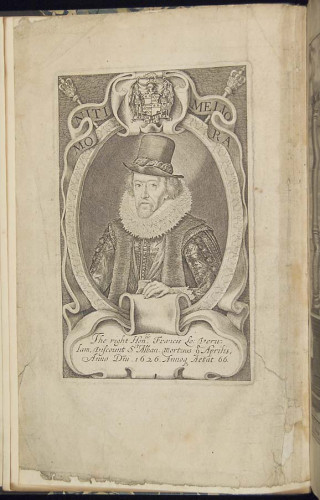
Francis Bacon (1561-1626). Sylva Sylvarum: or A Naturall Historie. In Ten Centuries. London: William Lee, 1627.
The life of Francis Bacon, Viscount St Alban (1561–1626), embodies many of the ideals and expectations of the Renaissance humanist. Active in the politics of the court of James I, Bacon was also a man of letters whose vast philosophical work would challenge the traditional methods of scientific inquiry.
During his studies at Trinity College, Cambridge (1573-5), Bacon became aware of the shortcomings of a curriculum utterly dominated by Aristotelianism. Critical of the deductive method, Bacon's writings would fully explore the proposition that our knowledge of the world must begin with an exhaustive computation of observation and experience.
The culmination of Bacon's philosophical thought was the publication of Francisci de Verulamio, summi Angliae cancellarii, Instauratio magna (London: John Billius, 1620). This volume includes a six-part division of his whole philosophical programme (Instauratio Magna), the incomplete second part of this plan (Novum Organum), a sketch of the third part (the phenomena of the universe, or a natural and experimental history for the foundation of philosophy), and a catalogue of particular histories.
Shortly after the death of Bacon in 1626, his personal secretary, William Rawley, published a commemorative volume with 32 Latin poems in his honor: Memoriae honoratissimi domini Francisci, Baronis de Vervlamio, Vice-comitis Sancti Albani Sacrum (London: John Haviland, 1626). Committed to promoting Bacon's intellectual reputation, Rawley subsequently edited and published other treatises by Bacon. Our Collection Highlight, Sylva Sylvarum: or A Naturall Historie. In Ten Centuries, belongs to a group of philosophical tracts that were published posthumously. Although our copy is dated 1627 in both the engraved and printed titles, the sheets and collation are actually identical to the first edition of 1626, except that the printed title-page is dated 1627. The Latin title perfectly describes the structure of the volume: "a miscellany of topics." More explicitly, it is an anthology of one thousand paragraphs consisting of extracts from many books, mostly from antiquity, and Bacon's own experiments and observations. At the end of the volume, Rawley also included the New Atlantis. A Worke vnfinished. This brief tract is a description of a utopian island and its scientific community: Salomon's House.
The Sylva Sylvarum is particularly fascinating as it contains numerous passages dealing with medical treatments for the prolongation of life and the preservation of flesh. Bacon, for instance, digresses on the virtues of nitre and opium to preserve the strength of youth:
"There be two things, which (inwardly vsed) doe coole and condense the spirits; And I wish the same to be tried outwardly in vapours. The one is nitre, which I would haue dissolved in Malmesey, or Greeke-wine, and so the smell of the wine taken; Or if you would haue it more forcible, poure of it vpon a fire-pan, well heated, as they doe rose-water, and vinegar. The other is, the distilled water of wilde poppy; which I wish to be mingled, at halfe, with rose-water, and so taken with some mixture of a few cloues, in a perfuming-pan. The like would be done with the distilled water of saffron flowers (Century X, pag. 249)."
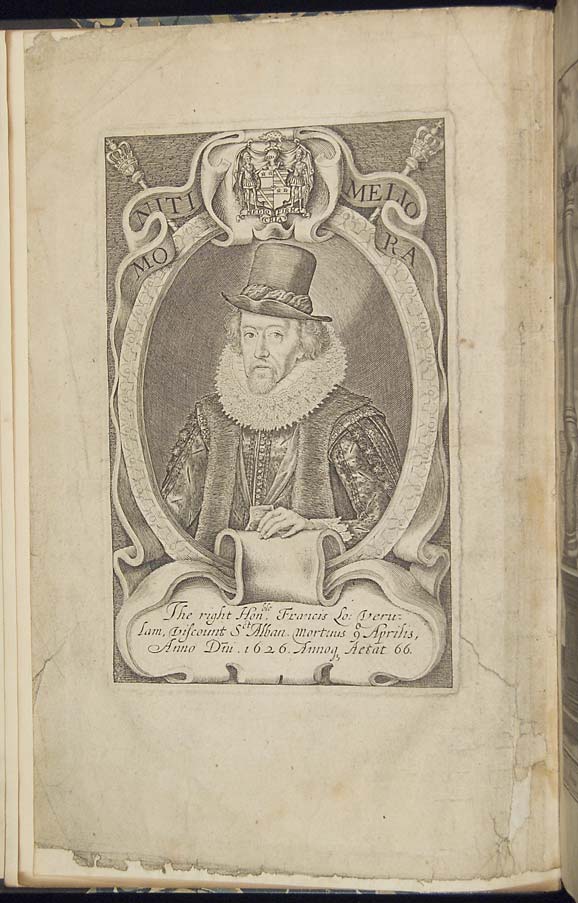
The page carrying the engraved portrait of Bacon is facing a title-page with an allegorical engraving (see the image included below). Many scholars would be tempted to describe this illustrated allegory as the 'frontispiece' of the book. Strictly speaking, however, the frontispiece is the portrait of Bacon since this bibliographical term actually refers to the illustration facing the title-page. While some may consider these technical distinctions an act of pedantry, they are extremely useful in describing the exact layout intended by the publisher without the aid of images.
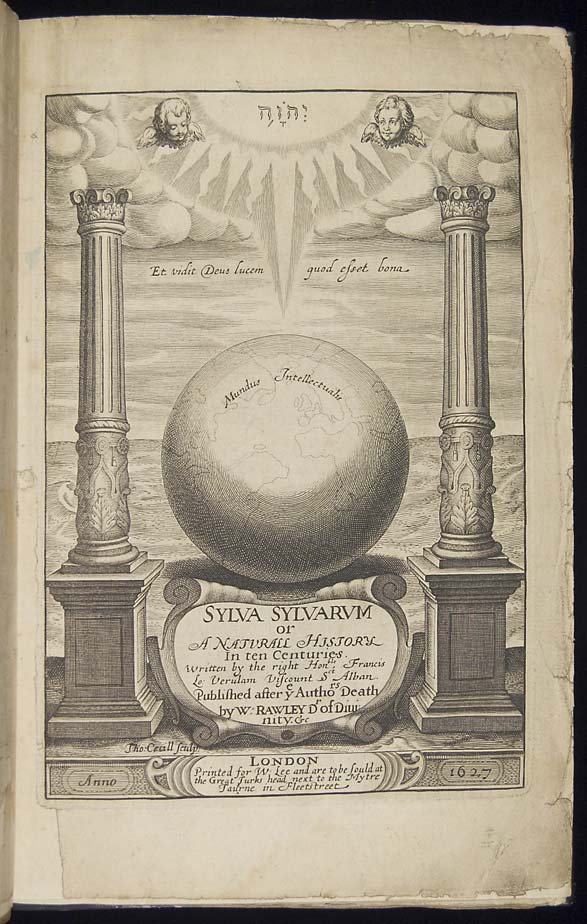
As shown above, at the top of the engraving a version of the tetragrammaton (Greek for "the four letters") is inscribed on the center of a sacred sun that emanates rays. In the Hebrew Bible, the four letters for the name of God, YHWH, were written but considered too sacred to be pronounced. As opposed to the consonant Hebrew text, in the Masoretic text the tetragrammaton is written with the vowels of "Adonay" (my Lord) to remind the reader to utter "Adonay" instead of the name of God. This is the representation we find in this illustration. In Elizabethan England, Calvinist doctrine exercised a great ideological influence on Protestant thought, forbidding any anthropological representation of God the father. Considering also that Protestants encouraged the study and translation of the Old Testament, it should not surprise us that representations of the tetragrammaton became a popular choice for the depiction of God in Protestant Europe.
Within the rays there are two cherubim, the one on the left is looking down while the one on the right is gazing at the sacred name. The middle ray is longer than the others, illuminating a huge globe below. This ray also divides the Latin inscription, Et vidit Deus lucem/ quod esset bona ( Genesis 1.4): And God saw the light, that it was good. The phrase Mundus Intellectuallis is inscribed across the globe. One can also see that the countries of the world are subtly outlined with dotted lines. The globe rests on a sea extending to the horizon. Flanking the globe, two great pillars with square bases and Corinthian capitals stand on the strip of land in the foreground. In a cartouche below the globe, we learn about the title of the book and one name: W. Rawley. Within the last compartment below, oval cartouches include the following imprint information: London: W. Lee, 1627.
Although Bacon never stated that the Sylva Sylvarum was intended to be included in the third part of his Instauratio , Rawley was convinced that the content of this treatise strongly indicated to do so. In the address to the reader he wrote: "Besides, this Naturall History was a debt of his, being designed and set downe for a third part of theInstauration. " To emphasize this connection, the title-page of the Sylva Sylvarum heavily borrowed from the design of the title-page of the Instauratio . The latter displays two columns rising from opposite lands. Between these two columns, there is an estuary leading to the open ocean beyond. There are two ships: one sails forth from the sea passage, the another already approaches the horizon. This layout was based on the device of the emperor Charles V, designed by Luigi Marliano of Milan to symbolize his rule: the motto plus ultra refers to the Spanish empire, then extended over the territories of the New World beyond the Atlantic Ocean. The columns of Marliano's device are the Pillars of Hercules, which traditionally established the western limits of the Ancient world (Rock of Gibraltar and Mount Hacho, located at the eastern end of the Strait of Gibraltar), the so-called ne plus ultra . To Bacon, the columns of Hercules metaphorically represented the authors included in the curriculum. For instance, in the dedication to the King in the second book of The Two Bookes of Sr Francis Bacon, of the Proficience and Advancement of Learning, Divine and Humane (Oxford: Thomas Huggins, 1633) (first published in 1605) Bacon says: "for why should a few received authors stand up like Hercules Columnes ; beyond which these should be no sailing, or discovering, since wee have so bright & benigne a starre, as your Maiesty, to conduct and prosper vs?" (pag. 92). This is a reference to Aristotle and scholasticism in general. Conversely, the two ships of this title-page represent the human desire for knowledge. Just below the ship of the foreground, a Latin inscription reads as follows: Multi pertransibunt et augebitur scientia: Many shall run to and fro, and knowledge shall be increased ( Dan. 12.4). One can easily see the inclusion of this biblical reference as an attempt to provide a religious sanction for the new geographical discoveries as well as the advancement of science. Whereas in his work and letters Bacon often denounces superstition and religious controversies as burdens for the progress of natural philosophy, we should not assume that he and other defenders of the new science, or true philosophy as it was commonly called, established a drastic separation between scientific research and the main foundations of the Christian faith. In truth, the proponents of the new science believed that a better knowledge of the world would ultimately glorify its Creator. For example, in his Micrographia: or, Some physiological descriptions of minute bodies made by magnifying glasses. With observations and inquiries thereupon (London: J. Martyn and J. Allestry, 1665), Robert Hooke argues that only a divine creator could have been responsible for the complexity of small bodies as they are seen under the microscope:"Whereas in the works of Nature, the deepest discoveries shew us the greatest Excellencies. An evident argument, that he that was the Author of all these things, was no other then Omnipotent; being able to include as great a variety of parts and contrivances in the yet smallest discernable point, as in those vaster bodies (which comparatively are called also points) such as the Earth, Sun, or Planets" (pag. 2).
Furthermore, Bacon often expressed the notion that the intervention of God was essential to make knowledge of the world accessible. For instance, in the first book of the Proficience and Advancement of Learning , he refers to the existence of divine agents that carry the enlightening power of God:
"To proceede to that which is next in order from God to spirits: We find as farre as credit is to bee given to the celestiall Hierarchy, of that supposed Dionysius the Senator of Athens the first place or degree is given to the Angels of love, which are tearmed Seraphim ; the second to the Angels of light, which are tearmed Cherubim ; and the third, and so following places to thrones, principalities, and the rest, which are all Angels of power and ministry; so as the Angels of knowledge and illumination, are placed before the Angels of office and domination" (pag. 54-5).
The engraved title-page of the Sylva Sylvarum overall reflects a similar approach. Religious sanction of the scientific enterprise is exemplified by the quotation fromGenesis : "And God saw the light, that it was good." And the fact that the two cherubim are gazing in different directions, the one looking at the tetragrammaton, the other at the globe below, indicates that they know that the divine light is falling on the Mundus Intellectuallis , the world of human knowledge. Specifically, this intellectual globe should be identified with the physical world, or the object of study of natural history. Likewise, Rawley, who appears on both the engraved and printed title-pages of theSylva Sylvarum as ‘Doctor of Divinity', tried to reconcile the new scientific method with Christian orthodoxy. At the end of his preface to the reader, he states: "I will conclude with an vsuall speech of his Lordships. That this work of his Naturall History , is the world as God made it; For that it hath nothing of imagination" (sig. A3).
It is very likely that the seventeenth-century reader would not have found serious difficulties to decipher the complex association of ideas contained in this iconographic scheme. In the previous century, there had been a great demand for books of emblems and devices, a type of literature that heavily used hieroglyphics, symbols and allegories, by freely borrowing from the Egyptian, Biblical, early Christian, and medieval traditions. Moreover, apart from glorifying both the author and his work, these illustrated title-pages were also a useful marketing tool. We should not forget that in the first three centuries of printing, most books were sold in unbound sheets. Consequently, these luxuriously engraved title-pages, or frontispieces, were a useful tool for the publisher to attract the interest of a potential buyer.
For the interpretation of the rich imagery of Sylva Sylvarum 's engraved title-page, I am greatly indebted to Margery Corbett and R.W. Lightbown's The Comely Frontispiece: The Emblematic Title-Page in England 1550-1660 (London, Henley and Boston: Routledge & Kegan Paul, 1979), 184-9.
Following the allegorical engraving is the printed title-page.
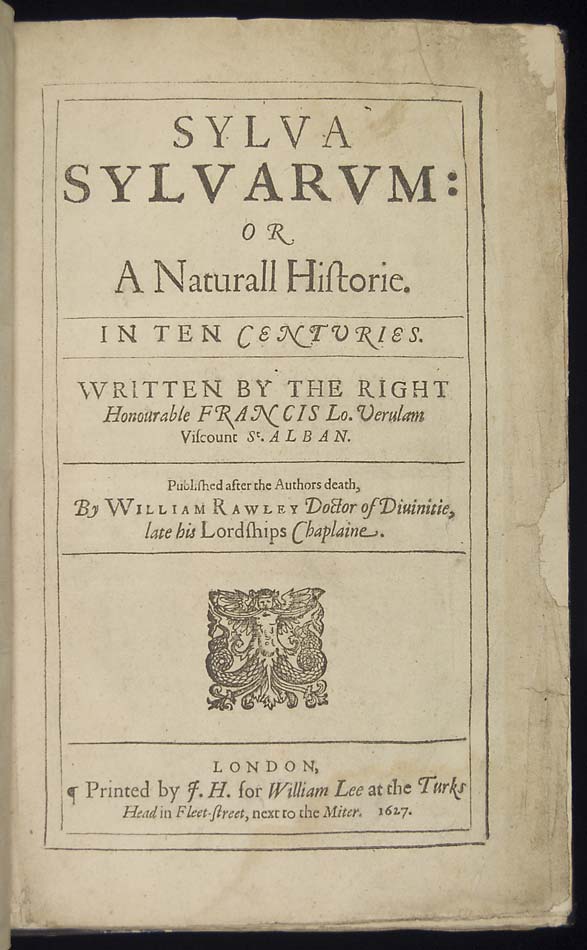
The first page of the dedication to Charles I is shown below.
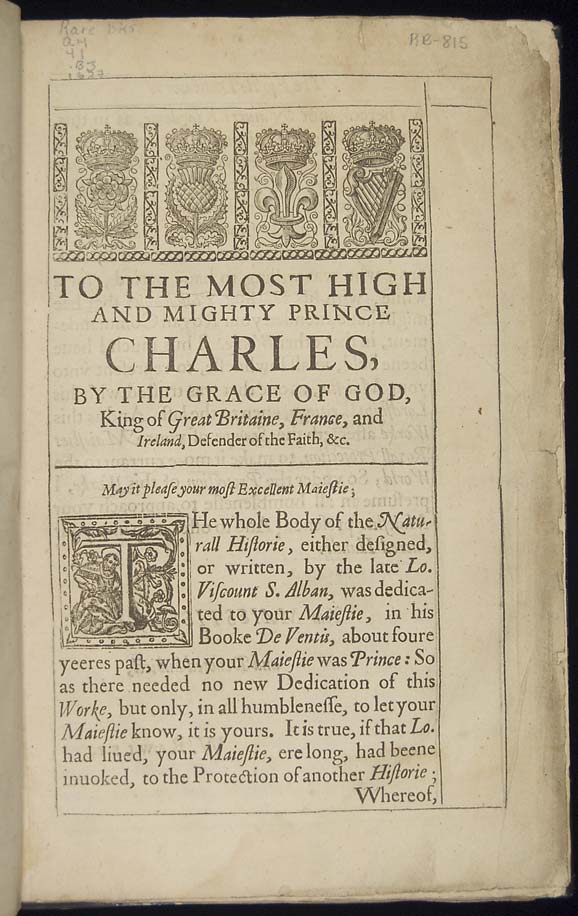
As an editor of those Bacon’s works that were published posthumously, Rawley always included a preface, customarily called "To the reader," to digress about the scientific and philosophical relevance of the treatise.
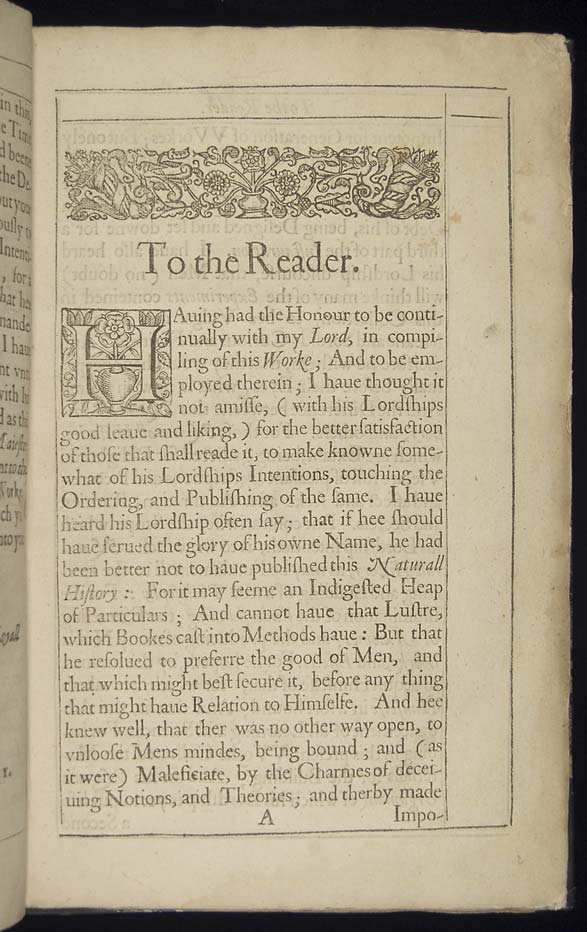
Finally, I would like to include a brief bibliographical note. As you might have observed in the three previous pictures, the pages of this book contain a frame, a box of lines surrounding the text. This device could also split the text into columns, a characteristic appearance of the page in English seventeenth-century books, for example in the first edition of Milton's Paradise Lost. Frames were built with brass rules, and, as in the page displayed below, they usually included brief summaries of the text in its margins so that the reader could quickly locate the desired passage.
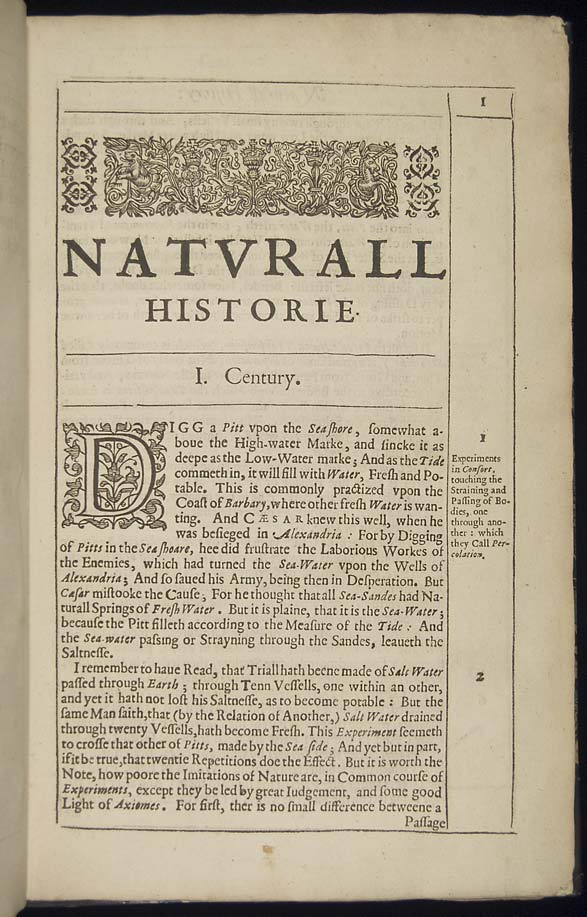
This blog entry was originally contributed by Pablo Alvarez, Curator of Rare Books at the University of Rochester from 2003 to 2010.
Selected Bibliography
Bietenholz, Peter G. and Thomas B. Deutscher. Ed. Contemporaries of Erasmus: A Biographical Register of the Renaissance and Reformation. 3 vols. Toronto: University of Toronto Press, 1885-7.
Corbett, Margery and R.W. Lightbown. The Comely Frontispiece: The Emblematic Title-Page in England 1550-1660. London, Henley and Boston: Routledge & Kegan Paul, 1979.
Gibson, R. W. Francis Bacon; a Bibliography of his Works and of Baconiana to the Year 1750. Oxford: Scrivener Press, 1950.
Jardine, Lisa and Alan Stewart. Hostage to Fortune: The Troubled Life of Francis Bacon. New York: Hill and Wang, 1999.

